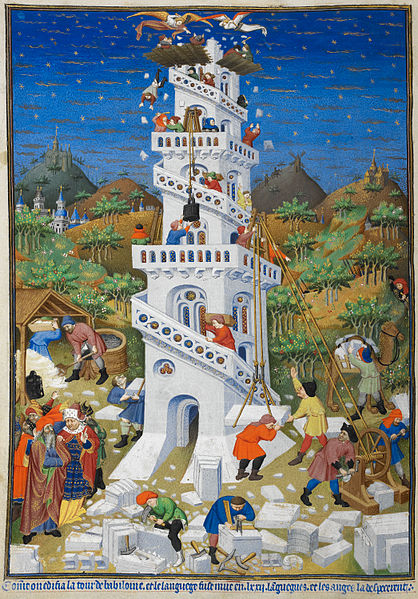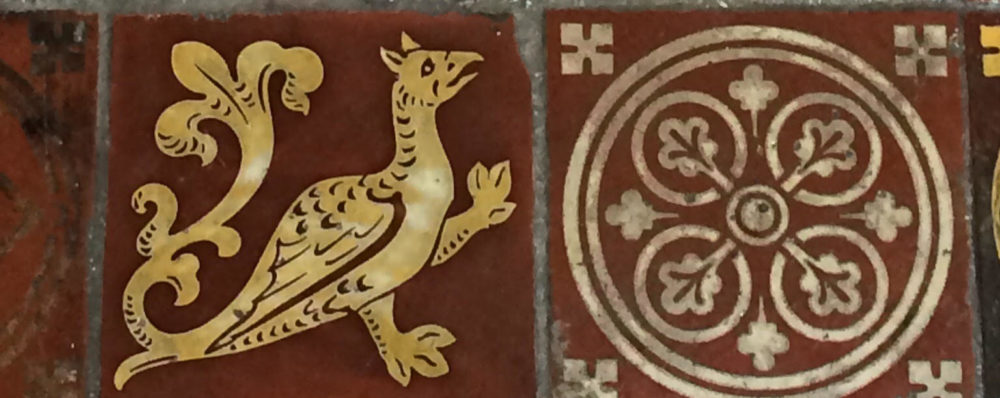
Building of the Tower of Babel, manuscript illumination from approx. 1410 (British Library Add MS 18850 f17v)
The constellation Orion, also identified in some folkloric traditions as Nimrod, is seen most clearly in the night skies of the northern hemisphere from January-March each year. Also, with the approach of Ash Wednesday and the beginning of Lent, Nimrod appears in classical Christian hymnography and sermons as one of the archetypal images of opposition and rebellion against God.
In Hebrew and Christian tradition, Nimrod is considered the leader of those who built the Tower of Babel in the land of Shinar, though the Bible never actually states this. (The illumination above shows Nimrod supervising the construction of the Tower of Babel in the lower left corner.) Nimrod’s kingdom included the cities of Babel, Erech, Accad, and Calneh, all in Shinar. (Genesis 10:10) Therefore it was likely under his direction that the building of Babel and its tower began; in addition to Flavius Josephus, this is also the view found in the Talmud and later midrash such as Genesis Rabba. Several of these early Judaic sources also assert that the king Amraphel, who wars with Abraham later in Genesis, is none other than Nimrod himself.
Judaic interpreters as early as Philo and Yochanan ben Zakai (1st century AD) interpreted “a mighty hunter before the Lord” (Heb. : לפני יהוה, lit. “in the face of the Lord”) as signifying “in opposition to the Lord.” Some rabbinic commentators have also connected the name Nimrod with a Hebrew word meaning ‘rebel’.
The historian Josephus wrote:
Now it was Nimrod who excited them to such an affront and contempt of God. He was the grandson of Ham, the son of Noah, a bold man, and of great strength of hand. He persuaded them not to ascribe it to God, as if it were through his means they were happy, but to believe that it was their own courage which procured that happiness. He also gradually changed the government into tyranny, seeing no other way of turning men from the fear of God, but to bring them into a constant dependence on his power. He also said he would be revenged on God, if he should have a mind to drown the world again; for that he would build a tower too high for the waters to reach. And that he would avenge himself on God for destroying their forefathers.
Now the multitude were very ready to follow the determination of Nimrod, and to esteem it a piece of cowardice to submit to God; and they built a tower, neither sparing any pains, nor being in any degree negligent about the work: and, by reason of the multitude of hands employed in it, it grew very high, sooner than any one could expect; but the thickness of it was so great, and it was so strongly built, that thereby its great height seemed, upon the view, to be less than it really was. It was built of burnt brick, cemented together with mortar, made of bitumen, that it might not be liable to admit water. When God saw that they acted so madly, he did not resolve to destroy them utterly, since they were not grown wiser by the destruction of the former sinners; but he caused a tumult among them, by producing in them diverse languages, and causing that, through the multitude of those languages, they should not be able to understand one another. The place wherein they built the tower is now called Babylon, because of the confusion of that language which they readily understood before; for the Hebrews mean by the word Babel, confusion …
Nimrod, the great hunter, is also said to hunt the newborn Abraham and attempt to slay him, much as Herod slew the infant boys of Bethlehem in an attempt to slay the infant Christ. Nimrod has thus remained in both Jewish and Islamic tradition an emblematic evil person, an archetype of an idolater and a tyrannical king, and often called “Nimrod the Evil.”
